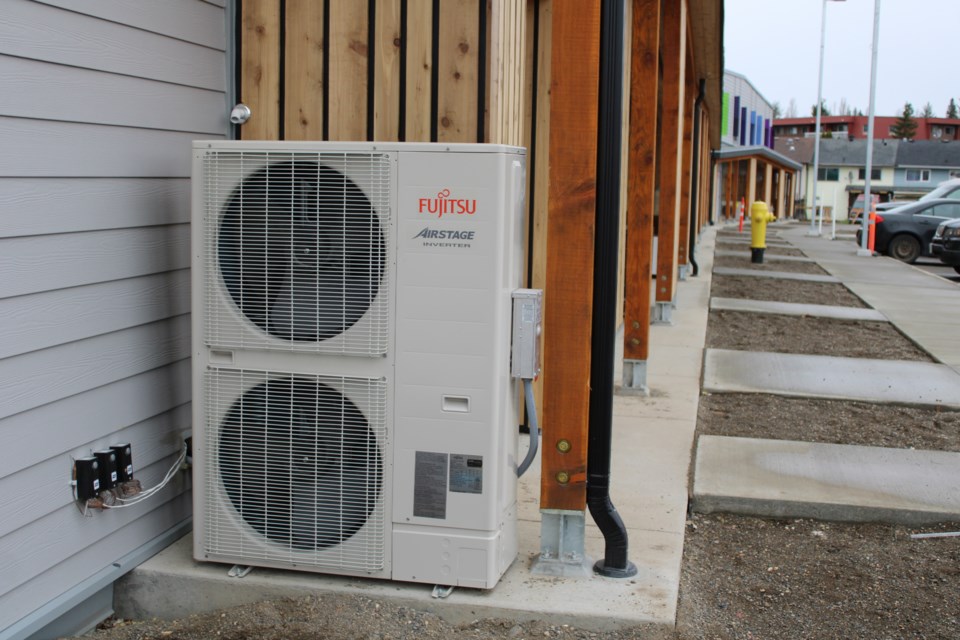A remarkable and largely invisible energy transition is underway and picking up speed across British Columbia’s cities and communities. No one is making much of a fuss about it because it’s mostly happening out of sight and out of mind — behind construction-site fencing, high on office-tower rooftops, and tucked away in basement utility rooms.
That said, it’s something to celebrate.
We’re talking about building electrification — the steady and sensible shift away from burning natural gas in boilers and furnaces to produce heat and hot water for commercial and multi-family buildings, and towards using all-electric equipment to do the same job — only better. In some B.C. communities, our research shows that with careful planning, a fully electric apartment or condo building can cost nearly one third less than an equivalent building heated with gas.
This shift has been underway for years, but several drivers have recently converged to pick up the pace. These include a wider range of technologies, a larger and steadily growing pool of qualified equipment installers, growing confidence in B.C.’s electricity system, and early adopters that are proving the economics of fossil-free buildings.
Then there’s the regulation, of course. All levels of government have adopted targets to reduce greenhouse gas emissions, and British Columbia’s exceptionally clean grid — BC Hydro’s generation is at least 98 per cent non-emitting — have cemented electrification as a lead solution to deliver on them.
High-efficiency buildings cost 30 per cent less
While electric cars tend to hog the spotlight, all-electric buildings are just as important — if not more so. Buildings that burn fossil fuels account for over half of the carbon pollution produced by big cities such as Â鶹´«Ã½Ó³»and Victoria. Governments have long relied on incentives and rebates to nudge developers and property managers to adopt all-electric heating and cooling equipment and are now starting to roll out requirements that will further speed along the shift that is already underway.
For example, more than a dozen B.C. local governments are now using the Zero Carbon Step Code to require low- or zero-emissions new construction in their communities; about 44 per cent of all new highrise residential towers are being built in communities that have adopted the Zero Carbon Step Code. Meanwhile, the City of Â鶹´«Ã½Ó³»is rolling out mandatory carbon reporting and limits for large existing buildings. And the Province of British Columbia is consulting on planned rules that could altogether by 2030.
What will all this cost? Fortunately, at least when it comes to new construction, all-electric building heating and cooling projects already pencil out.
In 2021, the Zero Emissions Building Exchange (ZEBx) — a Vancouver-based education and research-focused industry association — analyzed seven all-electric multi-family developments in B.C.’s Southern Interior and South Coast. The group found that companies could build all-electric multi-family developments for less than the average cost of a comparable new natural gas-heated development. In two of the assessed projects, the developers than the cost of comparable fossil-fuel buildings that meet the minimum requirements of the B.C. Building Code.
You read that right. With careful planning, these developer-builders brought hundreds of high-performance all-electric new homes to market, and construction costs came in 30 per cent below those of comparable conventional natural-gas buildings.
All-electric buildings are not only a bargain to build, but some evidence also suggests that they’re cheaper to operate, too. The Building to Electrification Coalition (B2E) is a network of utilities, builders, architects, and heating and cooling contractors that is teaming up to identify and overcome obstacles to all-electric buildings. The group recently evaluated the energy costs of a new . In 2021, per-unit energy costs averaged $14 per month, including heating, cooling, and hot water. This was despite that year’s deadly heat dome and late-December deep freeze.
Heat pump adoption growing but hurdles remain
This is of course all thanks to that amazing machine, the heat pump. Electric heat pumps are common across Asia and, in recent years, Europe has seen an extraordinary increase in their adoption. Norway, despite its frigid climate, is now the country with the highest heat pump penetration in the world. Despite this, until recently you would have been hard pressed to find them in B.C.
The tide started to change about five years ago with the introduction of municipal, provincial, and BC Hydro rebates. Since 2018, about 30,0000 electric heat pumps have been installed across the province. While the growth in heat pump adoption has predominantly been in temperate southwestern B.C., where electric heat pumps can operate during the coldest times of the year without a back-up heating system, there is also growing interest in B.C.’s colder regions.
Yes, they work up north. from Oxford University found that heat pumps are more efficient than natural-gas furnaces even in temperatures as low as –30 Celsius. A growing number of northern B.C. homes are now being built with them as the primary heating source.
For many decades, natural gas was simply the default energy source for space and water heating. But the blue flame era is now ending. With the growing awareness of the opportunities and benefits associated with all-electric, zero-emissions buildings — and a nudge from regulators — commercial and multi-family developers and property managers are steadily transforming our homes and offices to make them healthier, cleaner, and more resilient.
There are hurdles still to be solved; for example, retrofit financing options remain few and far between. But building electrification is the most exciting and uplifting climate-solution success story underway here in British Columbia and beyond. If you know someone who could do with a boost — and these days, let’s face it, that’s most of us — then feel free to pass it on.
Roberto Pecora is the director of the (ZEBx) and Mariko Michasiw is the program manager of the . Both are programs of the .



